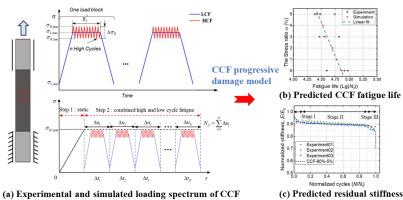考虑载荷相互作用影响的复合材料层合板高低周疲劳累进损伤模型
IF 9.8
1区 材料科学
Q1 MATERIALS SCIENCE, COMPOSITES
引用次数: 0
摘要
提出了考虑载荷相互作用的疲劳渐进损伤模型,用于预测复合材料层合板的高、低周联合疲劳寿命和残余疲劳性能。该模型结合了疲劳失效准则、疲劳损伤演化、残余性能退化和归一化疲劳寿命模型。考虑低周疲劳和高周疲劳的相互作用,计算了CCF载荷下的累积疲劳损伤,并对残余刚度和强度模型进行了改进。建立了综合疲劳模拟程序,对复合疲劳载荷进行等效处理,计算疲劳寿命。在LCF和CCF上进行了实验测试,验证了模型的准确性,仿真结果与实验结果吻合良好。讨论了CCF的关键参数CCF的应力幅比、频率比和LCF的应力比对疲劳寿命和剩余刚度的影响。本文章由计算机程序翻译,如有差异,请以英文原文为准。

A combined high and low cycle fatigue progressive damage model for composite laminates considering the effect of loading interaction
A fatigue progressive damage model considering the loading interaction is introduced to predict the combined high and low cycle fatigue (CCF) life and residual fatigue properties of composite laminates. This model incorporates fatigue failure criteria, fatigue damage evolution, residual property degradation and a normalized fatigue life model. By considering the interaction between low cycle fatigue (LCF) and high cycle fatigue (HCF), the cumulative fatigue damage under the CCF loading is calculated, and the models for residual stiffness and strength are improved accordingly. A comprehensive fatigue simulation procedure is established to perform equivalent treatment on the combined fatigue loads and calculate the fatigue life. Experimental tests on LCF and CCF are carried out to validate the accuracy of the proposed model, and the simulated results demonstrate good consistency with the experimental results. Moreover, the key parameters in CCF, such as the stress amplitude ratio of CCF, frequency ratio of CCF and stress ratio of LCF, are discussed in terms of their effects on fatigue life and residual stiffness.
求助全文
通过发布文献求助,成功后即可免费获取论文全文。
去求助
来源期刊

Composites Science and Technology
工程技术-材料科学:复合
CiteScore
16.20
自引率
9.90%
发文量
611
审稿时长
33 days
期刊介绍:
Composites Science and Technology publishes refereed original articles on the fundamental and applied science of engineering composites. The focus of this journal is on polymeric matrix composites with reinforcements/fillers ranging from nano- to macro-scale. CSTE encourages manuscripts reporting unique, innovative contributions to the physics, chemistry, materials science and applied mechanics aspects of advanced composites.
Besides traditional fiber reinforced composites, novel composites with significant potential for engineering applications are encouraged.
 求助内容:
求助内容: 应助结果提醒方式:
应助结果提醒方式:


